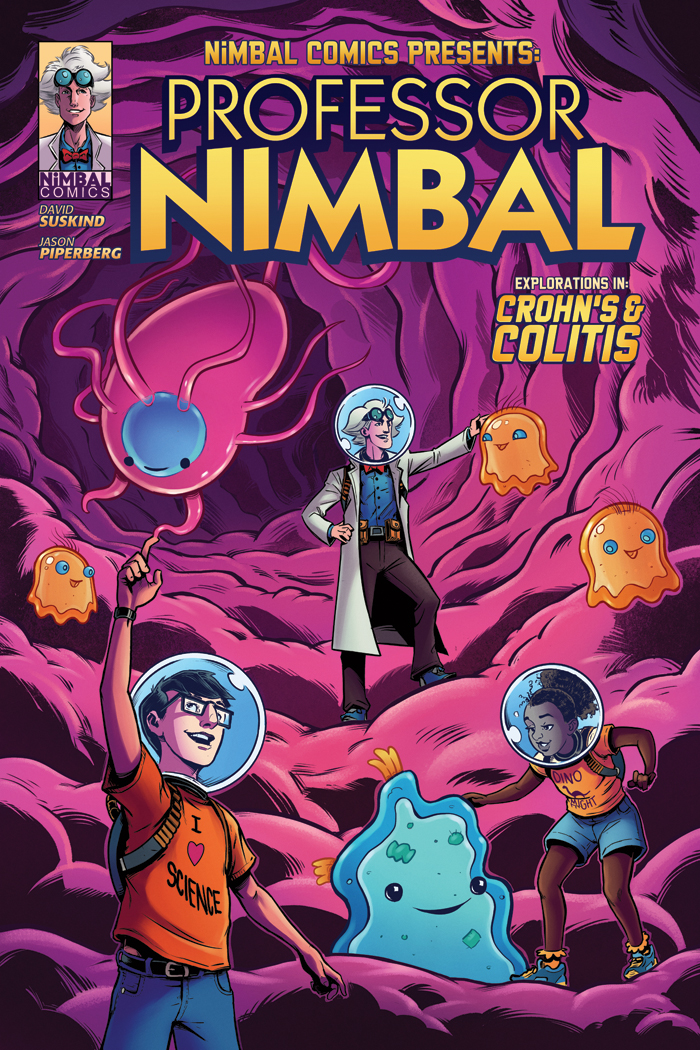Making SCD Work Outside the House
SCD at School
504 plan
A 504 Plan is worthwhile whether your child is on the SCD or not. A 504 Plan refers to Section 504 of the Rehabilitation Act and the Americans with Disabilities Act, which specifies that no one with a disability can be excluded from participating in federally funded programs or activities, including elementary, secondary, or postsecondary schooling. This includes illnesses or injuries as well as chronic conditions like asthma, allergies, and IBD. Depending upon the support you have from school officials, staying on the SCD during school hours can be challenging, and having a 504 Plan in place can help your child comply.
Here are two common accommodations that will help support your student:
- “Late arrival” allows your child to skip first period, which, in middle and high school, begins very early in the morning. It allows more time to prepare and eat a proper breakfast at home before going to school. Eating breakfast and maintaining a consistent energy level is key to preventing “cheating on the diet” at school. But be aware of the possible drawbacks of this option:
- With late arrival, the school bus is not available, which often results in the parent needing to drive the child to school.
- “Permission to access, carry, and eat snacks in class.” Since backpacks are typically stored in hallway lockers, it is important to ensure access to food whenever the child feels they need it. This helps when an impromptu pizza party is held in class, or when a box of cookies is shared in the classroom (which happens a lot in high school). With proper permission in place, your child can go get an SCD snack from his or her backpack when these situations arise.
Extra food and emergency snacks
Make sure to pack extra food and snacks daily, and include SCD muffins, cookies, crackers, or other treats as insurance against non-SCD temptations.
In addition to SCD food in the lunchbox, it is a good idea to have an emergency snack available in a pocket of your child’s backpack. This must be a nonperishable item like a fruit leather bar, a bag of seeds and nuts, or some SCD beef jerky. It is handy for days when unexpected delays may raise a need for food before getting home (e.g., staying late at school to coordinate a last-minute class project, or if the school bus is delayed). An extra SCD snack will keep energy up and temptation at bay.
Important! Be sure to check that the emergency snack is in place on a daily basis (your child might forget to tell you that it has been eaten). Replace the snack often. This also ensures that it didn’t spoil or that it didn’t turn into an unappetizing squished mush at the bottom of the backpack.
Packing and container strategies
Keep a collection of different sizes and shapes of lunch boxes, thermos cups, and water bottles. These are not just for school, but also for sports, evening outings, parties, etc. Having a variety on hand ensures that packing food in a hurry is easy and not stressful, and if a lunch box is forgotten at school, there is another one available for the next day. In addition, have several different types of lunch bags and carriers available, besides the individual containers that go inside them. These carriers should be in various sizes for any sort of outing, such as small and discreet for a movie theater, or larger for a picnic outing or school lunch.
SCD and Eating out
Food is not only important to ensure proper growth and development, but it is a profoundly social activity. As children and adults, we like to sit around the table “and chew the fat,” so to speak. Being with friends and family during meals is important, but being on the SCD and eating out can be difficult. Different people address this issue in different ways. It is important to remember that everyone’s levels of sensitivities are different, and therefore dining out involves caution and some advance planning.
Bringing your own food ensures that what you are eating is truly SCD safe. As mentioned before, you can ask your healthcare provider for a letter to ensure that whatever restaurant or other venue you visit won’t give you a hard time.
Some restaurants, especially nicer establishments that focus on customer satisfaction or healthful dishes, may actually be able to accommodate the SCD. It is important to properly communicate with them (ahead of time if necessary) to make sure that eating out will be feasible. Salads, vegetables, fish, and other foods are doable! But avoid complex dishes and sauces in which unknown ingredients may lurk.
If you live in an area with others on the SCD, it might be worthwhile focusing on a few local restaurants that know about and can accommodate the SCD. Just as there were almost no restaurants 15 years ago that provided gluten-free foods and now a plethora of them exist, so it can be with the SCD. Raising awareness by politely asking restaurants to create SCD-safe dishes is a way each of us can help change society and improve our dining climate.
SCD and Family Gatherings and Holidays
Holidays and family gatherings can be difficult. Empowering your child and yourself is the most important part to avoid slip-ups in the diet. But even when people are empowered, it can be hard. As a diabetic child, I remember the enormous numbers of cakes and pies around our house during the holidays. I also recall that family and friends would bring over sugar-free foods for me and lay them out on the table, well-marked and very conspicuous. Although I am sure I never mentioned it to my parents, it did annoy me—to the point that I went out of my way to eat the sugar-laden foods instead.
Empowerment is important, but having a sense of ownership for the individual on the SCD is key to its success. Make being on the SCD as least intrusive as possible, especially during holidays and major social gatherings. Talk with your child prior to the event and make a game plan to make the experience fun, easy, and nonintrusive. There are many ways to do this!
- First, make sure that as many “shared” foods as possible are available. Remember that the vast majority of foods are SCD-safe and are delicious whether you are on the diet or not. A great example is the beautiful turkey on the cover of Ramad Prasad’s Recipes for the Specific Carbohydrate Dietcookbook would make anyone salivate.
- Second, stop, or as my mother would say, “shut down” any friend or family who tries to tempt you or your child away from the SCD. Be proactive and proud.
- Third, for food items that are distinctly SCD, make sure you and your child know where they are and how to serve and integrate them into the meals.
- And finally, the most important thing to remember about family gatherings and holidays is to have fun and be happy. Although this may seem simplistic or even naïve, it is good to remember why we are celebrating and to be thankful for what we have.
Sports is an important part of life for many children. Being on the SCD should not stop individuals from participating and excelling in whatever athletic endeavors they choose. Most of the time, having adequate snacks and hydration available is enough to maintain a child’s physical activity. But for children with IBD, having a sufficient supply of high-energy foods and balanced electrolyte solutions can be especially important. Fortunately, nature gives us many of these foods—bananas and oranges, for instance, are great sources of calories and nutrients.
- Always carry an official letter (see page Downloadable papers) from your doctor stating your need to be on a medical diet and to carry your own food. Make a few copies—it may be useful at places such as restaurants and movie theaters.
- If carrying yogurt will be a hassle, plan ahead and order SCD-legal probiotics to use instead of yogurt.
- Take any necessary medication or supplements in their original containers.
- Always take more food than you think you may need. Carry water bottles and nonperishable snacks in your pocket or personal backpack in addition to the food in the coolers. Travel days make people more hungry than on a routine day. Extra food is also an insurance in case of unexpected delays and other mishaps.
An SCD letter from your doctor(See downloadable papers)
“This individual must maintain a therapeutic diet and must be permitted to carry his own safe food.”
Snacks
- Water bottles
- SCD-legal fruit juice
- Hard cheese cubes
- Dehydrated beef jerky
- Fruit leather
- Legal LaraBars
- Dried fruit and nuts
- Fresh fruit and cut veggies
- Hard-boiled eggs
- SCD cookies and crackers in airtight containers
Frozen SCD Main meals
- Veggies
- Soups and stews
- Meat patties
- Pickles
- Canned fish and chicken
- Salt and pepper
- Other seasonings
Breakfast
- Frozen pancakes (portioned daily servings in zipper-lock storage bags) with cooked fruits and honey
- Eggs
- Sausage
- Tea bags
For the hotel
- Probiotics, S. boulardii, other key supplements (keep cool or refrigerated)
- An electric hotplate with a pot to heat liquids and a skillet for eggs
- Or an electric frying pan to heat liquids and cook or reheat foods
- A Pyrex or ovenproof glass dish to warm frozen SCD meals (small enough to fit in the tiny hotel microwave)
- Mugs
- Spoons and forks
- A small sharp knife
- Picnic plates
- Aluminum foil or parchment paper
- Small zipper-lock storage bags
- Large zipper-lock storage bags (to replenish ice cubes in car coolers)
- Paper towels
- Sponge and dish soap
In the Car
- Hand sanitizers
- Several coolers with ice packs. To keep these cool, every morning place new zipper-lock storage bags full of ice from the hotel dispenser or convenience store.
- If you have a refrigerator in your hotel room, chill blue icepacks in the freezer overnight.
- A car refrigerator is optional. Be aware that the effective car fridges are very large and expensive than the standard cooler.




